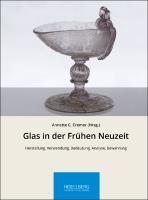Glas in der Frühen Neuzeit
Single-Blind-Peer-Review overseen by Series Editor
Herstellung, Verwendung, Bedeutung, Analyse, Bewahrung
Contributor(s)
Cremer, Annette Caroline (editor)
Language
English; GermanAbstract
The production of glass was one of the high technologies of the early modern period. At a heat of around 1500 degrees, mixtures of sand, lime and vegetable, wood or potash were transformed into greenish, crystal-clear or colorful marvels in the glassworks of Europe. Its aesthetic and material properties-transparency, workability, and durability-made glass a coveted material that was still the preserve of the elite in the 16th century and did not become an affordable mass product until the second half of the 18th century.
The volume Glass in the Early Modern Period pursues an interdisciplinary approach. It takes its starting point in the conditions of glass production in early modern glassworks, the high consumption of resources, and the resulting social conflicts. The volume focuses on the various historical forms of use, glass as an object of collection, and its allegorical meaning in painting. At the same time, the volume deals with the analysis and preservation of glass objects from a scientific and conservation perspective and with the presentation of baroque glass from a museum perspective. In all of this, a close connection to the court culture of the European nobility is apparent, who acted as pioneers, patrons and, not least, buyers, users and collectors of the glass objects. In this way, many of the luxury objects have been preserved to this day. Die Herstellung von Glas gehörte zu den Hochtechnologien der Frühen Neuzeit. Bei ca. 1500 Grad Hitze verwandelten sich in den Glashütten Europas Gemenge aus Sand, Kalk und Pflanzen-, Holz- oder Pottasche zu grünlichen, kristallklaren oder bunten Wunderwerken. Seine ästhetischen und materiellen Eigenschaften – Transparenz, Bearbeitbarkeit und Dauerhaftigkeit – machten Glas zu einem begehrten Material, das im 16. Jahrhundert noch den Eliten vorbehalten war und erst in der zweiten Hälfte des 18. Jahrhunderts zum erschwinglichen Massenprodukt wurde.
Der Band Glas in der Frühen Neuzeit verfolgt einen interdisziplinären Zugang. Er nimmt seinen Ausgang bei den Bedingungen der Glasproduktion in den frühneuzeitlichen Glashütten, dem hohen Ressourcenverbrauch und den daraus entstehenden sozialen Konflikten. Im Zentrum des Bandes stehen die verschiedenen historischen Nutzungsformen, Glas als Sammlungsgegenstand sowie dessen allegorische Bedeutung in der Malerei. Zugleich befasst sich der Band aus naturwissenschaftlicher und konservatorischer Perspektive mit der Analyse und Bewahrung der Glasobjekte und aus musealer Sichtweise mit der Präsentation von barockem Glas. Bei allem zeigt sich eine enge Verbindung zur Hofkultur des europäischen Adels, der als Wegbereiter, Förderer und nicht zuletzt Käufer, Nutzer und Sammler der Glasobjekte auftrat. Auf diesem Weg sind viele der Luxusobjekte bis heute erhalten geblieben.
Keywords
Glass, Glass production, Glassware industry, Glassworks, Glas, Glasherstellung, Glasindustrie, GlashüttenDOI
10.17885/heiup.821ISBN
9783968220710, 9783968220703Publisher
Heidelberg University Publishing (heiUP)Publisher website
https://heiup.uni-heidelberg.de/Publication date and place
Heidelberg, 2022Imprint
heiUPSeries
Höfische Kultur interdisziplinär. Schriften und Materialien des Rudolstädter Arbeitskreises zur Residenzkultur, 6Classification
Ceramics, mosaic and glass: artworks
History of art


 Download
Download Web Shop
Web Shop